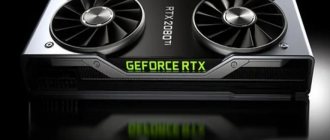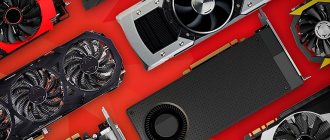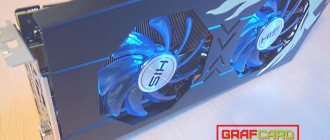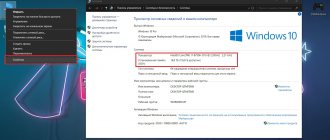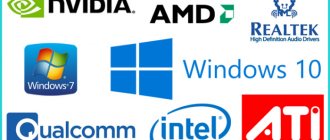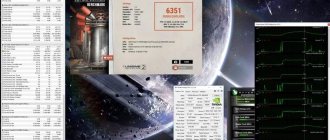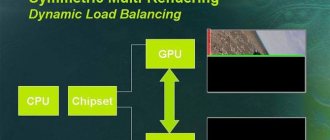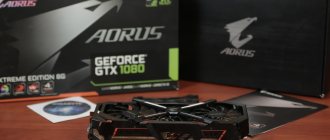User budget
All video cards are divided into price segments, and most ordinary PC and laptop users are not particularly willing to shell out money for all sorts of video cards. If price is the main choice factor for you, then first you should decide on the “family” of video cards.
There are only two of them on the Russian market:
- nVidia. These video cards boast greater support for various technologies such as PhysX or 3D Vision.
- AMD. This “family” of video cards, in turn, has a better price-quality ratio, and, in principle, the price of AMD video cards is significantly lower.
Each of these two manufacturers has video cards divided into different price segments. There are several such video card segments:
- Infra-budget price segment. Video cards from this price segment are used as an alternative to the built-in video chip in motherboards and are the cheapest on the market. For nVidia these are video cards like GF210-220 or GF510-520, and for AMD - HD4550 or HD
- Budget price segment. Such video cards are suitable for replacing old ones. For example, if you suddenly urgently have to replace your old video card because it has broken down, then this is exactly the price segment that you need. Because usually video cards from the highest price segment fall into this segment when newer and more powerful models appear. In this case, the buyer can purchase an excellent, powerful video card at an affordable price, but of a previous version. For the average PC user, the model version does not play a significant role - therefore this scenario is the best. nVidia has such video cards as GF440 or GF240, and AMD has HD5670 or HD
- Middle price segment. The most common video cards on the market, since their characteristics are much higher than those of previous price segments, and the price is significantly lower than that of further video card segments. These graphics cards are designed for any purpose and need, and they handle gaming or graphics work well. For nVidia these are video cards GF450, GF460, etc.; AMD video cards like HD5750, HD6750, HD5850 fall into this price segment .
- Highest price segment. Video cards in this price segment are the standard of power and performance. The advantage of these video cards is that they are up to date. After all, even a card from nVidia GF285 series still does not experience slowdowns or interruptions in operation. From nVidia you can purchase such video cards of the GF285, GF470, GF580 series, from AMD - HD6950, HD6990, HD. The choice of these video cards depends only on the capabilities of your wallet, because they are quite expensive, sometimes almost as much as your computer.
But, naturally, price is not the most important criterion for choosing a video card. Its characteristics are much more important. It is precisely these that we will analyze further.
The main components of video cards that affect its characteristics:
- Graphics core (GPU, graphics chip or processor).
- Video memory.
- DAC controller.
- Video controller/VDC.
- Video card cooling system.
Selecting a video card. Factors influencing the buyer when choosing a video card.
What you need to know when choosing a video card. Technical characteristics of the video card that affect performance. Selecting a video adapter. Technical aspects affecting video card performance. For the most part, the guideline for choosing a video card is the level of accelerator performance.
Then: the presence of certain interface connectors, power consumption, noise level of the cooling system, heat dissipation. But since performance still plays the main role, when choosing a video card you need to take into account various factors and technical features of a particular product. In simple words, you need to know what the video card consists of, who is responsible for what, and which component influences what. For most users, technical terms do not mean anything, so I suggest you familiarize yourself with the parameters displayed in the data sheet of the video card or the product catalog of any store.
A video card is a video card is a video adapter is a graphics card is a graphics card is a graphics accelerator is a graphics card is an ati radeon hd or nvidia geforce.
Video adapter - video card - a device (electronic board) that converts data, images (text and graphics) located in computer memory into a digital or analog video signal for a display (monitor). A video card is an expansion card that has a universal PCI-Express (PCI-E) connector, present on any modern computer system motherboard. Also, the video card can be integrated - built-in - soldered into the computer motherboard or into the Intel CPU - Core i3 / Core i5.
Basic elements of a video card. The technical side of choice. First of all, you need to know that any video card is based on two elements - the GPU (Graphics Processor Unit - graphics processor) and graphics RAM (GDDR). These video adapter components are closely interconnected.
GPU, graphics processor , is a microprocessor responsible for calculations related to the processing of graphic information for further display of images on the monitor. To speed up calculations, the GPU uses unified functional blocks: shader processors, texture units, rasterization (blending) units. For example, the Radeon HD 4870 video card has the following indicators: 800/40/16. Each block is responsible for a specific type of calculation (texturing, geometric construction, etc.).
You need to consider the ratio of blocks within the framework of one video card developer; the indicators of ATI and Nvidia are not identical. The number of functional units with a GPU clock speed determines the performance of the video card microprocessor. The GPU also has a built-in memory controller that provides direct communication with the graphics memory.
Video card memory. Graphics memory is used for temporary storage and exchange of information required by the graphics processor of the video card for computing operations. The memory stores both newly received information, intermediate results, and calculated images ready for display on the monitor. When choosing a video card, you should consider: type, size, clock frequency and memory bus.
The type of graphics memory is the use of memory chips of a certain standard in the manufacture of video cards. Here you need to be careful, since memory chips of different standards can be used to manufacture video adapters of the same series. Let's say the Nvidia GeForce 9600GT 512 MB video card is available with DDR2 and GDDR3 memory. And the data sheet of the card or the product catalog should indicate the following GeForce 9600GT DDR2 512 MB or GeForce 9600GT GDDR3 512 MB video card. Today, four video memory standards are used in the production of video cards: DDR2, GDDR3, GDDR4, GDDR5.
One thing to remember is that DDR2 is the outdated, slowest and cheapest memory. It has a detrimental effect on the performance of the video card and is installed to reduce the cost of products. In general, the higher the number, the faster and more powerful the graphics memory. The most widely used chips are GDDR3 and GDDR5.
All presented standards have one common technical feature - the ability to perform two operations in one clock cycle. Therefore, in the designation of memory clock speed there are two meanings: the real clock frequency and the effective one. The effective frequency is the real frequency multiplied by two (2 operations per clock).
Memory clock frequency – characterizes the computing power (performance) of the memory subsystem (processor), determines the number of operations performed by the memory per second. More is better. To ensure data exchange with the GPU of the video card, a memory bus is used.
Video card memory bus – (translated from English) a bidirectional unified switch, a set of conductors for transferring data between the graphics processor and video card memory. The performance of a bus is determined by its width - the amount of data in bits transmitted by the bus in one clock cycle. At the moment, the optimal memory bus parameters are: for ATI – 256bit, for Nvidia – 256bit and 512bit.
The memory capacity of a video card is the sum of the installed memory chips. Today, the optimal memory size for mid-class video cards is 512 MB. For high-end video cards, 1 GB of memory, since only they are able to use the entire amount of video memory. With high game settings and high resolution, the amount of information and the need for additional memory increases.
A weak GPU will simply not be able to calculate all the information and most of the graphics memory will be idle. Large amounts of memory are needed for high-performance graphics processors on video cards. Everything else is a trick of marketers; they install more memory, but most often with a lower clock frequency or even DDR2.
Choosing a video card for games 512 or 1024mb.
The market for graphics accelerators (video cards) is dominated by two manufacturers - NVIDIA brand GeForce and ATI brand Radeon. There are a large number of different models, lines, series, and modifications of video cards from these manufacturers on sale. In order to distinguish them and not get confused, I suggest you familiarize yourself with the markings, numbering, and designations of video adapters.
The video card suffix means precision in choice.
I'll start with the general features. For both ATI Radeon 5xxx and Nvidia GeForce 9xxx or 2xx, the first digit indicates the line (generation) of video cards. The second number of Radeon 58xx or GeForce 98xx (28x) is responsible for the hierarchy of models in the line based on performance. Large numbers mean greater productivity. This is where the similarity of designations ends.
The third digit for the ATI Radeon 587x replaced the previously used suffixes (xx90 = X2 two in one, xx70 = XT, xx50 = PRO). The xx50 suffix indicates a lower GPU clock speed, fewer functional units, and slower memory. And as a result of lower video card performance.
For the same purposes, Nvidia uses suffixes in the form of prefixes immediately after the numbers GeForce 9600 GT or GeForce 9600 GS. In this case, the suffix with the letter S (GS) indicates worse video card functionality and performance (similar to xx50). Also see the review of video cards: Nvidia GeForce GTX 260 and GeForce GTS 250.
Reference video card. Video adapter developers ATI and Nvidia set reference values for GPU and memory clock speeds, as well as the type and amount of video card memory. In turn, video card manufacturers have the right to change these characteristics in order to increase performance, improve the cooling system or reduce the cost of products.
Most often, the clock speed of the graphics processor and video card memory are subject to changes, and less often the volume and type of memory. The reference video card ATI Radeon HD 4850 512MB will have the following characteristics - chip and memory frequency 625\1986 MHz, functional units 800\40/16, memory capacity 512MB, memory type GDDR3, memory bus 256 bit.
Connecting the video card to the motherboard or video card interface. Today, the PCI Express x16 connector is widely used, replacing the previously used AGP interface. There are still video cards with AGP on sale, but the last model worth attention was released quite a long time ago - the ATI Radeon HD 3850.
To connect a monitor, TV, or projector to the video card, the interface connectors installed on the video adapter are used. Modern video cards have two digital DVI connectors, rarely DVI plus the outdated analog D-Sub. The best option is a video card with a DVI interface and the latest HDMI, with the ability to connect a high-resolution TV and HDCP audio.
We also read - a personal gaming computer, the influence of the right and wrong choice of processor and video card. The influence of the processor + video card combination on computer performance. Why do we need a performance balance for computer components and how does it affect the final performance of a home PC in games - choice, selection of a video card to the processor.
That's probably all you need to know when choosing a video card. I hope this information will help you in your choice and protect you from being deceived by an unscrupulous seller. If this article helped you, you can say thank you or leave a comment. I also advise you to read the article about the relationship between the central processor and video card.
When copying material, a reference to the site is obligatory!
Best wishes Denker.
Selecting a video card.
Graphics core
It has several names (GPU, graphics chip, graphics processor), but the essence remains the same. The core is the basis of the video card and the speed, performance and capabilities of your PC depend on it. The main tasks of the GPU are calculations for the output image and calculations for processing 3D graphics commands.
The most important technical characteristic of a GPU is the frequency, measured in megahertz (MHz). The higher the frequency, the faster and more powerful the video card. When choosing between two video cards, you should look at this criterion.
How in practice
Let's look at several options for comparing different video cards.
Example #1
Let's start with the Nvidia GeForce GTX 760 and 960.
FPS in games on 7th and 9th generation boards was tested in 16 games: Dying Light, Dragon Age: Inquisition, The Crew and others. “Framerate” is practically the same, with the exception of a few points. Why is that? Let's compare the technical characteristics of video cards:
GeForce GTX 760 – GeForce GTX 960
GPU frequency: 1006 MHz – 1253 MHz
Local video memory: 2048 MB – 2048 MB
Data bus: 256 bits – 128 bits
Average price: 13,000 rubles – 23,000 rubles
Based on these three indicators, it is already clear that it is not worth overpaying 4-5 thousand rubles for the sake of a slightly smoother operation of the toys. The lower processor frequency is compensated by the throughput of the video card.
Example #2
Now let's look at the GTX 780 Ti, 970 and 980. The performance test was carried out in the RPG The Witcher 3: Wild Hunt.
And this time we see that the overclocked 780 Ti produces identical results in FPS tests as the 970 model. The difference is 3-4 frames/sec. What played a role here?
GeForce GTX 780 Ti – 970
GPU frequency: 1163 MHz – 1178 MHz
Local video memory: 4 GB – 4 GB
Data bus: 256 bits – 256 bits
Memory frequency: 7240 MHz – 7000 MHz
Average price: 15,500 rubles – 21,000 rubles
Surprisingly, the characteristics of both video cards are almost the same, which gives approximately similar performance indicators in games. NVIDIA GeForce GTX 980 benefits from supporting more technologies than its predecessor.
Upcoming games are expected to support DirectX 12.0. The developers promise a “huge” increase in FPS due to software optimization. 900 series video cards already support the new standard.
Video memory
This is the second most important characteristic that affects the performance of a video card.
There are several types of video memory: DDR, DDR2, GDDR3, GDDR5 . In theory, this gradation determines memory speed, but the characteristics are still more important:
- The amount of memory , which is measured in megabytes (MB).
- Memory bus width, measured in bits.
- Memory clock speed.
Special attention should be paid here to memory bus width , because it is a parameter that determines the performance of video memory and video card in principle. Large bit depth allows you to transfer a large amount of information to the graphics chip and back. The bit depth is also divided into price segments and ranges from 64 bits (infra-budget segment) to 1024 bits (highest price segment) and even higher. Considering that the bit depth (width) of the memory bus is more important than the amount of memory, when choosing between two video cards with characteristics of 512 MB + 256 bits and 1024 MB + 128 bits, you should choose option 1. Since the bandwidth of this video card will be higher, which means the overall performance of the computer will be much better.
Operating frequency of video memory
Also a characteristic of video memory. A characteristic that determines the speed of writing and reading data from the video card memory. Here again there is simple logic - the higher the number of this characteristic, the better. Video memory frequency is measured in megahertz (MHz) or gigahertz (GHz).
And the last characteristic of video memory is volume. This is not the most important indicator, although, in theory, it should be the other way around. But no, if you take two video cards that differ only in memory size, then their performance will differ by only a couple of percent. But a video card with a large amount of memory will cost 10-15% more. So there is no point in charging more when the differences will be completely invisible.
What determines the performance of a video card for mining?
Another important indicator is video memory timings, which are announced only for RAM, but for video card memory remain unnoticed by most users. Important for mining especially using the Dagger Hashimoto algorithm. Divided into three types:
- stock ones, installed by the manufacturer - reduce the power of the device to make it energy efficient;
- overclocked or fast – optimized for mining;
- extreme or aggressive - will allow you to squeeze out even more, which can affect the stability and durability of the device.
Graphics chips of the same model can have different performance characteristics and overclocking potential precisely due to their latency values.
For working with Ethereum, for example, the number one indicator is the amount of graphical RAM. When mining this digital currency, a DAG file must always be present in its memory. It grows gradually (in a few days the volume can increase by a couple of megabytes) and 2 GB of storage for this file is not enough. If you are going to mine ether for a long time, it is better to pay attention to a video card with a memory capacity of 6 GB or more.
DAC controller
DAC – digital-to-analog converter. This is nothing more than an “adapter” between the digital and analog worlds (which you can listen to, see, etc.). Video cards need it in order to convert images into a signal type accessible to the monitor, that is, roughly speaking, to “assemble” the image on the screen.
The main parameter of the controller is frequency. Here you don’t have to look at what number is indicated; you should only pay attention to the “Maximum video card resolution” column. The standard in modern cards is the RAMDAC frequency, which is 400 Mhz.
Memory bus - optimal value? Video card memory bus width
Characteristics of video cards. What is a video adapter memory bus? What is affected by the video card bus width - 128bit, 256bit, 384bit, and what memory bus width to choose a video card with. Maxim: - Good day, Denker. I'm interested in the video card memory bus.
I read your correspondence with those “in need” and envied your patience and self-control. I hope you can bear with me too. My computer, like any mortal, has come to retire. It’s not possible to change all the components at once; I want to start with a video card for the future purchase of a motherboard with a processor and memory (if a power supply is required). I've been browsing Yandex Market for three days, looking at different video cards, evaluating the characteristics, and the further I go, the squarer my head becomes.
I called a friend to consult him, he seems to be rummaging through computers, but he can’t really say anything. He has a 9600GT 512Mb video card, 256bit memory bus. I went to the Nvidia website, compared the characteristics of its video adapter with those that I looked at on Yandex and was horrified! Its memory bus width is 256bit, and a bunch of video cards that are now on sale have a memory bus like mine - 128bit!
But his video card is also, to put it mildly, not new! I thought progress was being made, but it turns out that the video memory bus width of many new video cards is the same as that of my 4-year-old? This manufacturer is fooling us a little, it turns out? By increasing some parameters, leaving others at the same level? It is clear that there are video adapters with a 256-bit memory bus and with a 320-bit one. But they also cost more. I've already broken my head. What to choose - memory bus, frequency, or memory capacity of 2048 mb?
Here's an example - a Sparkle GeForce GTX 550 Ti 900Mhz video card, memory bus width 192bit, costs about 4,000 rubles. MSI GeForce GTS 450 783Mhz, ZOTAC GeForce GTS 450 875Mhz at 128bit cost about the same. ASUS GeForce GTS 450 594Mhz is a little cheaper and also has a 128bit memory bus.
What's the catch? At the manufacturer? Is there a Leadtek GeForce 9800 GT 550Mhz card, generally the video memory bus capacity is 256bit and also with 1GB of memory, so maybe it’s better, even though it’s ancient? So I want to know whether it makes sense to choose a video adapter based on the memory bus, or what parameter is still decisive when choosing a video card (except for money, of course), and which video card is better to buy for about 4,000 rubles.
Everyone here is interested in whether the processor will “interfere” with the video card, but I can’t understand how in the 128bit video cards I described the memory bus coexists with a frequency of 900 Mhz, if the 9800 GT at a frequency of 550 has a 256-bit memory bus? I apologize for the long letter. But the toad is pressuring me to pay 6-7 thousand for a video card, and my wife won’t understand.
Home computer: Motherboard: GA-M56S-S3 socket AM2 Processor: Athlon 64 x2 5200+ Video card: GeForce 8600GTS 256Mb bus 128bit Memory – 2 GB DDR2 800 Screws – 2 pcs. on 250 and 320Gb
Denker:
Video card memory bus. Is the video memory bus width the optimal value?
It’s a serious question, I think I could defend a dissertation on this topic, BUT. To spite the company's engineers, we will not climb into the jungle of scientific progress, but will look for the answer on the surface. For those who use the bus as a medical term, I’ll explain what a video card memory bus is, and then we’ll come to an understanding of the term memory bus width, what they eat with and how much is needed: 384bit, 256bit or 128bit is enough. So.
The video card memory bus is a highway connecting the graphics processor and video card memory. The memory bus provides data transportation (two-way exchange) between the GPU and memory. The amount of information transferred per clock cycle is called the bus bandwidth or the memory bus width of the video card.
In general, everything is extremely simple - the wider the channel provided by the bus, the more information for calculations is available to the graphics processor per unit of time. BUT. This is on the one hand, and this information about memory buses misleads many, since sellers, taking the opportunity to sell old stuff, very rarely reveal the second side of the coin.
Namely, in order to fully use the provided memory bus capacity, you need a sufficiently powerful GPU so that the increased video card bus is used to its fullest, and is not a price add-on. The same applies to the amount of video memory; excess memory is important for CrossFireX and SLI systems.
In modern video cards, the memory bus is a consequence of engineers’ struggle with three components - GPU power + video memory speed + price positioning of the graphics accelerator. In other words, the memory bus width is exactly what is needed for optimal price and performance of video cards.
Using your example with video cards - GeForce GTS 450 128bit memory bus and GeForce GTX 550 Ti 192bit video card bus - let's expand the idea by adding the number of GPU computing units and the nominal frequencies of the adapters. GTS450 = 192/32/16 - 783/1566/3600MHz and GTX550Ti = 192/32/24 - 900/1800/4100MHz, as you can see, the 550Ti is a little more powerful, a little faster and is provided with a larger memory bus channel width. Further larger and wider, as a result, the GeForce 450 video card, or rather its processor, can be considered the threshold value for the 128bit memory bus.
On the question of the manufacturer - marketers have made a significant contribution to inflating the concept of bus capacity. And sometimes it got to the point of ridiculousness - they set the memory bus as almost the main characteristic of the video card. I’m telling you the following - you don’t have to do something twice as much for it to work more efficiently - you can improve the technology. And also, I say - no to the 256bit GeForce 9800GT memory bus - the video card is outdated.
And my advice to the consumer is that when buying a video card at a price below $100, be sure to check the memory bus width; the manufacturer can cut this parameter to reduce the cost of the product. When buying a video adapter that costs more than $100, first of all, look at the performance tests of the reference sample video card (nominal from Nvidia or AMD ATI). This is more important - comparison of video cards tests 2014. The memory bus will be equal to the optimal value, cases of artificial reduction are reduced to zero.
When choosing a video card, place the main emphasis on the price/performance ratio, take into account the frequency, the amount of memory in relation to the nominal value, the possibility of overclocking or factory overclocking. Don’t ignore the memory bus width (you never know), but don’t pay too much attention to it either. And most importantly, do not forget to link the purchase of a video card with the purchase of a processor. What is more important: processor or video card?
CPU temperature program. . Missing d3dx9 dll - download. .
When copying material, a reference to the site is obligatory!
Best wishes Denker.
Video card memory bus.
Video controller, or VDC
The video controller is responsible for generating the final image, gives the command to the DAC for processing it, and is also responsible for receiving and transferring information from memory to image processing and output. VDC is the so-called “intermediary accomplice” in the processes of image processing and creation. This parameter does not directly affect the performance of the video card, but is responsible for the “quality of output images.”
Memory
The video card memory capacity can range from 512 to 4 GB. If you like to play computer games, then your best choice would be a video card with as much memory as possible, but keep in mind that devices with 3-4 GB of memory are very expensive, not every PC user can afford them. At the moment, the optimal solution is video adapters with 1-2 GB of memory.
Be aware that some video card manufacturers equip their products with a large amount of memory (for example, 2 or more GB), and the product is not very expensive. Don't fall for this trick - such video cards are very weak and won't run most modern games even at medium settings.
Manufacturers, wanting to sell their products, package some of their products with an excessively large amount of memory, which they do not need at all. To put it simply, the video card will indeed have 2 or more GB of memory installed, but most of the volume will not be used due to the low bandwidth (bit capacity) of the device. Have you noticed a video card with a lot of gigabytes in the store, and the price is surprisingly low? Don't rush to buy!
Video card cooling system
Modern video cards have taken over the function that was previously performed by the computer's central processing unit (CPU), namely video processing. Plus it took away a number of additional functions, for example, some arithmetic operations. Thus, video cards are becoming more and more powerful every time. Due to this, they require more power and generate more and more heat, and therefore a good cooling system. Almost every manufacturer has its own patented cooling system.
Cooling plays a huge role in both performance and lifespan of the video card, so you need to follow some simple criteria:
- Cooling must be active, that is, fans must be present.
- The more fans in the cooling system, the better.
- It is worth choosing a video card in which the diameter of the fans and the number of blades on them are larger.
- The presence of heat pipes and an abundant radiator is only a plus.
Cooling is a very important criterion. And if you have a choice between a medium-power video card, but with a good cooling system, and a powerful video card with one radiator, then it is better to choose the first one.
The concept of bit depth
You probably already know how a video card works, so I won’t go too deep into this topic. The GPU and video memory are separate units, each of which performs its own task. For data exchange, they are connected to each other by a special bus. Naturally, like any electronics, this component has certain limitations.
In this case, the performance of the video card as a whole is limited by the channel bandwidth, or bit rate. Most often you can find graphics accelerators on sale with the following performance:
- Budget - 64 bit;
- Middle class - 128, 192 or 256 bits;
- Top ones – 256 bits or 512 bits.
The final cost of the video card depends on the bit capacity, as well as on some other indicators. All other things being equal, a model with a higher bit rate will cost more, but its performance will be higher.
You can compensate for the lack of bandwidth by increasing the frequency of the core and video memory, for which you will have to use higher quality components. As a result, the price will still be higher.
This solution was first used by AMD in the Radeon HD 5xxx line (you've probably heard about them before), which at the time of release showed very good results.
I would also like to note that in terms of performance, a video card with DDR5 memory and a 128-bit channel width is not inferior to a device with a 256-bit channel width that uses DDR3 memory.
The most popular today are mid-class cards, with a channel width of 128 bits and 192 - they are the most represented on the market.
And yes, you can build an average gaming computer with such a video card if you don’t want to spend too much money on this idea.
